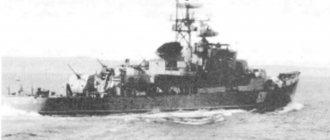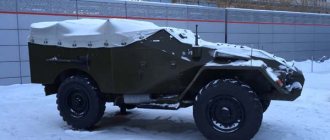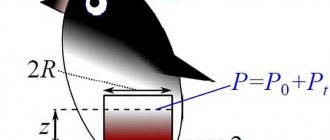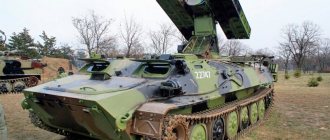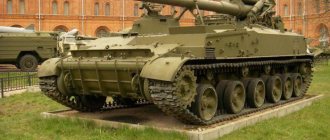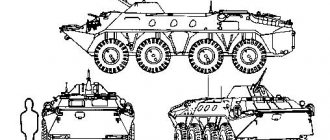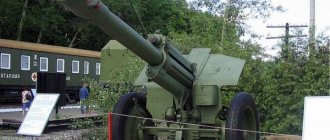| 85-mm anti-aircraft gun model 1939 (52-K) | |
| general information | |
| A country | USSR |
| Years of manufacture | 1939-1945 |
| Issued, pcs. | 14 422 |
| Weight and dimensions characteristics | |
| Caliber, mm | 85 |
| Barrel length, club | 55, 2 |
| Weight in firing position, kg | 4500 |
| Weight in stowed position, kg | 4500 |
| Firing angles | |
| Elevations (max.), ° | 82 |
| Decrease (min.), ° | -3 |
| Horizontal, ° | 360 |
| Fire capabilities | |
| Max. firing range, km | 15, 65 |
| Rate of fire, rds/min | up to 20 |
On a stamp of the USSR during the war years
52-K
(GAU index -
52-P-365
) is a Soviet 85 caliber anti-aircraft gun. The full official name of the gun is 85 anti-aircraft gun, model 1939. Created in Kaliningrad near Moscow by M. N. Loginov in accordance with the concept of engineer G. D. Dorokhin to modernize the 76-mm Loginov anti-aircraft gun of the 1938 model. It was actively used in the Great Patriotic War, and after its end it was in service with the Soviet Army for a long time before the adoption of anti-aircraft missile systems. The 52-K gun was transferred or sold to other countries to equip their armed forces. Some of the 52-K anti-aircraft guns, after being removed from service, were converted for peaceful use in mountainous areas as anti-avalanche weapons.
Characteristics and properties of ammunition
- Loading: unitary
- Ammunition range: Anti-aircraft fragmentation grenade with remote fuse T-5, TM-30, VM-30: 53-UO-365.
- Anti-aircraft fragmentation grenade with remote fuse VM-2: 53-UO-365,
- Anti-aircraft fragmentation grenade with adapter head and fuse KTM-1: 53-UO-365
- Armor-piercing tracer caliber projectile 53-UBR-365
- Armor-piercing tracer pointed-head caliber projectile 53-UBR-365K
- Armor-piercing tracer sub-caliber projectile 53-UBR-365P
- Anti-aircraft fragmentation grenade with T-5: 800
- Armor-piercing caliber: 9.2
- Distance 100 m: 120
85-mm anti-aircraft gun model 1939 (52-K)
The gun was developed by the design bureau of plant No. 8 in Kaliningrad near Moscow on the instructions of the State Autonomous Agrarian University. Its predecessor was the 76-mm anti-aircraft gun of the 1938 model created by M. N. Loginov, which was produced in a small series in 1938-1940. Due to the extremely short time frame allocated for the development of the new system, leading designer G.D. Dorokhin decided to put an 85-mm barrel on the platform of a 76-mm anti-aircraft gun of the 1938 model, using the bolt and semi-automatic mechanism of this gun. In 1939, a new 85-mm anti-aircraft gun with the factory designation 52-K underwent field tests, during which it was revealed that it was necessary to install a muzzle brake, increase the supporting surface of the bolt wedge and the breech socket. The weapon, modified in accordance with the recommendations of the scientific testing site, was adopted by the Red Army in the same year under the name “85-mm anti-aircraft gun model 1939.”[1]
At the beginning of the war, there were 3,082 guns available (3,016 in the Red Army and 66 in the Navy).
To increase the accuracy of firing at air targets, batteries of 85-mm anti-aircraft guns were equipped with PUAZO-3 artillery anti-aircraft fire control devices, which made it possible to solve the problem of meeting a projectile and an aircraft. In addition to the PUAZO devices, RUS detection radar stations were also used to control the fire of the 85-mm anti-aircraft gun units operating in the main directions. The gun was also equipped with a mechanical fuze installer designed by L. V. Lyulev.[1]
In order to increase the production of anti-aircraft artillery during the war, it was necessary to solve the problem of reducing the labor and metal intensity of products. The design of the 52-K gun was simplified, and at the same time its manufacturing technology was improved. In 1943, the improved gun was successfully tested, and in February 1944, the gun, which received the factory designation KS-12, went into mass production. The first two letters of the index meant that the gun was created at the plant named after. Kalinin in Sverdlovsk.[1]
Designed to combat enemy aircraft, to fire at airborne assault forces, at live ground targets and enemy firing points, these guns were also successfully used to destroy fascist tanks. The 52-K coped with an unusual task for an anti-aircraft gun more successfully than other anti-tank guns of those years. With an armor-piercing projectile attached to it, it could penetrate the armor of all types of tanks that were in service with the German army until mid-1943. And when in 1942 G.D. Dorokhin was awarded the title of State Prize laureate, the award noted not only the anti-aircraft, but also the anti-tank qualities of the gun.[1]
In service
- Algeria Algeria - 150 KS-19, as of 2020
- Bulgaria Bulgaria - a certain amount, as of 2016
- Guinea Guinea - 4 CS-19, as of 2020
- Egypt Egypt - 300 KS-19, as of 2020
- PRC PRC - a number of Type-59 (copy of KS-19), as of 2020
- Azerbaijan Azerbaijan - a certain amount, as of 2016
- Republic of the Congo Republic of the Congo - some, as of 2020
- DPRK DPRK - a certain number, as of 2020
- Cuba Cuba - some quantity, as of 2020
- Mauritania Mauritania - 12 COP-19, as of 2020
- Morocco Morocco - 17 COP-19, as of 2020
- Syria Syria - some, as of 2016
Notes
- International Institute for Strategic Studies.
The Military Balance 2020 / James Hackett. - London: Taylor&Francis, 2020. - P. 320. - 504 p. — ISBN ISBN 9781857438352. - International Institute for Strategic Studies.
The Military Balance 2020 / James Hackett. - London: Taylor&Francis, 2020. - P. 82. - 504 p. — ISBN ISBN 9781857438352. - International Institute for Strategic Studies.
The Military Balance 2020 / James Hackett. - London: Taylor&Francis, 2020. - P. 449. - 504 p. — ISBN ISBN 9781857438352. - International Institute for Strategic Studies.
The Military Balance 2020 / James Hackett. - London: Taylor&Francis, 2020. - P. 326. - 504 p. — ISBN ISBN 9781857438352. - International Institute for Strategic Studies.
The Military Balance 2020 / James Hackett. - London: Taylor&Francis, 2020. - P. 242. - 504 p. — ISBN ISBN 9781857438352. - International Institute for Strategic Studies.
The Military Balance 2020 / James Hackett. - London: Taylor&Francis, 2020. - P. 438. - 504 p. — ISBN ISBN 9781857438352. - The Military Balance 2020. - P. 455.
- International Institute for Strategic Studies.
The Military Balance 2020 / James Hackett. - London: Taylor&Francis, 2020. - P. 265. - 504 p. — ISBN ISBN 9781857438352. - International Institute for Strategic Studies.
The Military Balance 2020 / James Hackett. - London: Taylor&Francis, 2020. - P. 393. - 504 p. — ISBN ISBN 9781857438352. - International Institute for Strategic Studies.
The Military Balance 2020 / James Hackett. - London: Taylor&Francis, 2020. - P. 344. - 504 p. — ISBN ISBN 9781857438352. - International Institute for Strategic Studies.
The Military Balance 2020 / James Hackett. - London: Taylor&Francis, 2020. - P. 345. - 504 p. — ISBN ISBN 9781857438352. - International Institute for Strategic Studies.
The Military Balance 2020 / James Hackett. - London: Taylor&Francis, 2020. - P. 354. - 504 p. — ISBN ISBN 9781857438352. - The Military Balance 2007. - P. 312.
- The Military Balance 2007. - P. 196.
- V. Ilyin.
Attack aircraft and fighter-bombers. — P. 70. - A. Khaustov, A. Kotlobovsky.
European style tornado. — P. 19.
Operation history
In the absence of other anti-aircraft guns, 21-K guns were installed on all classes of ships of the Soviet fleet - from patrol boats and submarines to cruisers and battleships. Re-equipment of auxiliary vessels used for transporting weapons and ammunition with 45-mm AU 21-K made it possible to halve the losses of these vessels in the Northern Fleet.
The installation of 21-KM with increased weight reduced the already low metacentric height of the boats. The shields themselves, due to their large area, increased windage, and during a storm the waves tended to tear the cannon off the deck, so they were soon abandoned on small ships.
In the post-war period, 21-K was installed on the barrels of the main caliber guns of cruisers to perform firing training and save the life of more expensive heavy guns.
21-KM guns are still used on ships of the Russian Navy as salute guns.
Background to the development of the weapon
At the end of the 20s, the leadership of the USSR decided to concentrate the production of all small and medium-caliber anti-aircraft guns for the army and navy at plant No. 8. This included 37-mm anti-aircraft guns. The plant's capacity and its engineering staff left much to be desired.
The plant had never made automatic weapons before. The result was immediate: not only the production of 37-mm anti-aircraft machine guns mod. 1928, but also all other types. Among them were anti-aircraft guns 2-K (20 mm) and 4-K (37 mm), the manufacturing documentation and prototypes of which were transferred in 1930 by the German company Rheinmetall.
Over the three years of operation, Plant No. 8 produced only 75 2-K and six 4-K assault rifles, but none of them were completed. As a result, the armed forces of the USSR until 1940 were left without high-speed anti-aircraft guns.
Installation drawing
General information
KS-19 ensured combat against air targets with speeds of up to 1200 km/h and altitudes of up to 15 km. All elements of the complex at the combat position are connected to each other by electrical wires.
The gun is aimed at the lead point by a hydraulic power drive GSP-100 from PUAZO. But manual guidance is possible.
The KS-19 cannon is mechanized:
installation of a fuse;
chambering the cartridge;
closing the shutter;
firing a shot;
opening the bolt and extracting the cartridge case.
Preparation of the next shot begins with pressing the trigger handle of the automatic fuse installation.
Firing modes:
13 shots in 1 minute;
45 shots in 5 minutes;
110 shots in 60 minutes;
160 shots in 120 minutes.
Firing at the next target is possible in no less than 2.5 minutes.
The GSP-100M system is designed for automatic remote guidance in azimuth and elevation angle of eight or fewer KS-19M2 guns and automatic input into the ACF of values for setting the fuse according to PUAZO data.
The GSP-100M system provides the possibility of manual guidance on all three channels using indicator synchronous transmission. The GSP-100M system includes GSP-100M gun sets (according to the number of guns), a central distribution box (CDB), a set of connecting cables and a battery supply device.
The source of power supply for GSP-100M is a standard power station SPO-30, which generates three-phase current with a voltage of 23-133 V and a frequency of 50 Hz.
All guns, SPO-30 and PUAZO are located within a radius of no more than 75 m (100 m) from the CRY.
System design
The gun barrel consists of a pipe, breech, coupling, lining with basting, muzzle brake and nut.
Semi-automatic vertical wedge shutter.
The cradle is cast, in front it has a holder with three holes: one for the rollback brake cylinder, two for the rollback brake cylinders.
The mechanism for changing the rollback length is assembled on the right side of the cradle.
The tray is designed to hold the cartridge during installation of the fuse, to feed the cartridge into the loading line, and to guide it during loading. The tray is assembled on a bracket welded to the left wall of the cradle.
The rammer is hydropneumatic, with a hydraulic accelerator. Before the first shot, the rammer is cocked manually using a winch, then ramming is carried out using recoil energy.
The lifting mechanism has one gear sector mounted on the cradle. The lifting mechanism operates hydraulically and manually.
The turning mechanism includes a main gear engaged with a ring gear.
The balancing mechanism is spring-type, pulling, and has two columns.
The machine is a welded structure consisting of a cast base, right and left cheeks, reinforced with a stiffener, front and rear connections.
The KZU-16 platform is four-axle, with torsion bar suspension. Trolleybus-type wheels with GK tires,
The platform consists of: a frame with two stops, forward and reverse gears, two compensators (mechanisms to facilitate transfer from the traveling to the combat position and back) and smaller components.
The frame is a cross-shaped welded beam of box-section, with two side brackets for attaching folding stops. At the front of the frame, brackets are welded to guide the openers. A support ring with 16 holes for attaching the foundation slab is welded in the middle part of the frame.
Radar station SON-4
The gun guidance radar of the KS-19 air defense complex was developed on the instructions of the GAU with the active participation of A. A. Forshter and M. L. Sliozberg.
State proving grounds tests took place in 1947 with good results, after which the station was put into service.
SON-4 is a two-axle towed van, on the roof of which there is a rotating antenna in the form of a round parabolic reflector with a diameter of 1.8 m with asymmetric rotation of the emitter.
It had three operating modes:
all-round visibility for detecting targets and monitoring the air situation using the all-round visibility indicator;
manual control of the antenna to detect targets in the sector before switching to automatic tracking and for rough determination of coordinates.
automatic target tracking by angular coordinates for precise determination of azimuth and angle in automatic mode and slant range manually or semi-automatically.
SON-4 data
The station was supplied with magnetrons that operated in 4 bands, accordingly modifications of the anti-interference equipment were used.
System design
The gun barrel consists of a pipe, breech, coupling, lining with basting, muzzle brake and nut.
Semi-automatic vertical wedge shutter.
The cradle is cast, in front it has a holder with three holes: one for the rollback brake cylinder - the knurler, two for the rollback brake cylinders.
The mechanism for changing the rollback length is assembled on the right side of the cradle.
The tray is designed to hold the cartridge during installation of the fuse, to feed the cartridge into the loading line, and to guide it during loading. The tray is assembled on a bracket welded to the left wall of the cradle.
The rammer is hydropneumatic. Before the first shot, the rammer is manually cocked using a winch, then ramming is carried out using recoil energy.
The lifting mechanism has one gear sector mounted on the cradle. The lifting mechanism operates hydraulically and manually.
The turning mechanism includes a main gear engaged with a ring gear.
The balancing mechanism is spring-loaded.
The machine is a welded structure consisting of a cast base, right and left cheeks, reinforced with a stiffener, front and rear connections.
The KZU-16 platform is four-axle, with torsion bar suspension. Trolleybus-type wheels with GK tires.

